Hot, cheesy pizza loaded with your favorite veggies is one of the most fun and easy dinners to make at home. With just a few key tips you can create a restaurant-quality crust, and treat yourself to the best homemade pizza that’s completely customizable to your tastes. Plan your next pizza party using my foolproof Pizza recipe, with step-by-step photos for making perfect and best Veg Pizza from scratch every time!

About Veg Pizza Recipe
I promise you’ll never want to order delivery again after you see how easy it is to make pizza at home using fresh ingredients.
This recipe includes instructions for how to create a chewy crust that’s lightly crisp on the bottom using all-purpose flour or bread flour. It makes a dough that is far better (and cheaper!) than any store bought dough or restaurant pizza I have tried.
Even the tomato sauce is made from scratch! It’s wonderfully simple and flavorful, and is the perfect base for layering on lots of cheese and your choice of toppings.
Table of Contents
Not only is this homemade pizza recipe wholesome to make with no artificial ingredients, you don’t need any special kitchen equipment either.
The best pizzas are made in a very hot wooden fired oven and over a pizza stone. Of course our kitchen ovens cannot be compared with the hot commercial ovens. When making a homemade pizza, I suggest to use the highest temperature in your oven.
My family loves pizza. So I make it pretty often and am now a pro at it. I bake pizza using a pizza stone and also a baking tray or pan. Let me tell you that a pizza stone make a real difference to the texture of the crust.
I hear you! I know that every kitchen does not have a pizza stone. So I have kept this recipe simple enough where you do not need a pizza stone. Just use a metal pan or tray and you will get a crisp crust if you follow my outlined steps below.
I make pizza dough with both unbleached bread flour and unbleached all purpose flour. Bread flour having more gluten helps to have a chewy crispy crust. The texture of the pizza crust made with bread flour is so good.
Having said that, I do not mean that you cannot make pizza with all-purpose flour. Of course, you can and they will still taste good. With all-purpose flour, try to use the unbleached flour or opt for organic flour.
How to make Pizza Recipe
I have divided my step-by-step guide into 3 main sections for you to be able to make this best Veggie Pizza easily.
- Make pizza dough
- Make pizza sauce
- Assemble & bake
Make Pizza Dough
This recipe will make enough dough for 4 small or 3 medium sized or 2 large pizzas. It’s great for preparing ahead of time keeping in the fridge overnight for when you’re ready to use!
I have explained kneading dough with hands, but you could easily use a stand mixer.
Here’s how to make the best, easiest pizza dough from scratch:
1. First, in a large bowl mix together 1.5 teaspoons instant yeast and ½ teaspoon of sugar.
Usually instant yeast can be mixed directly in the flour or in water at room temperature. But I am detailing this method as it can be implemented if you are using dry active yeast. Add 2 teaspoons dry active yeast for this pizza crust recipe.
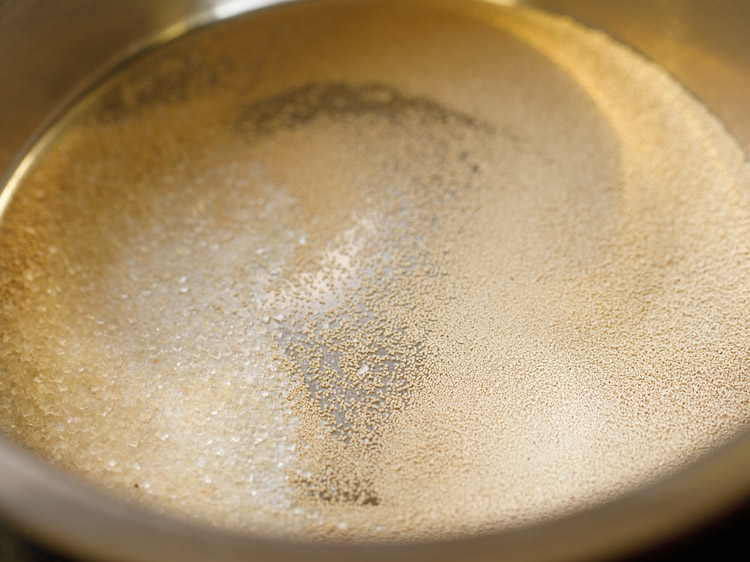
2. Add 1 cup of lukewarm water (44 degrees Celsius) and stir. Set aside and let the yeast activate.
Tip: The water has to be lukewarm and not hot or cold. Hot water will kill the yeast and cooler water won’t activate the dry active yeast.
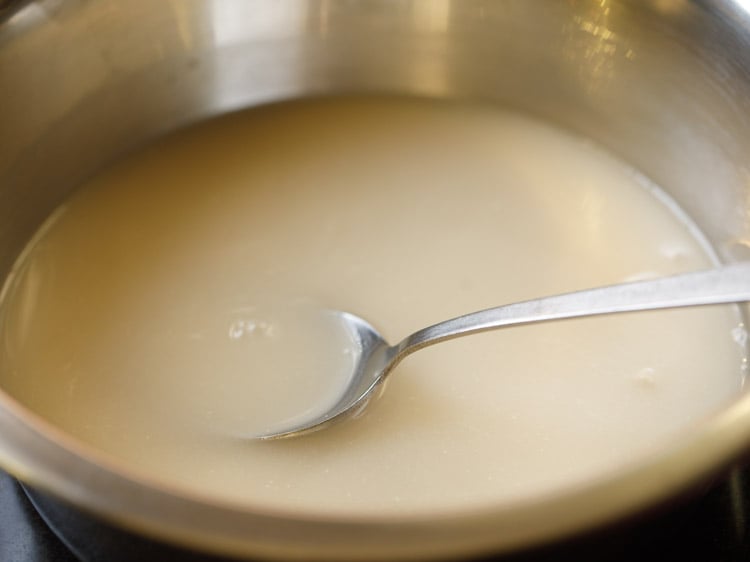
3. You should start to see the yeast mixture bubbling up and doubling in size after about 10 to 15 minutes.
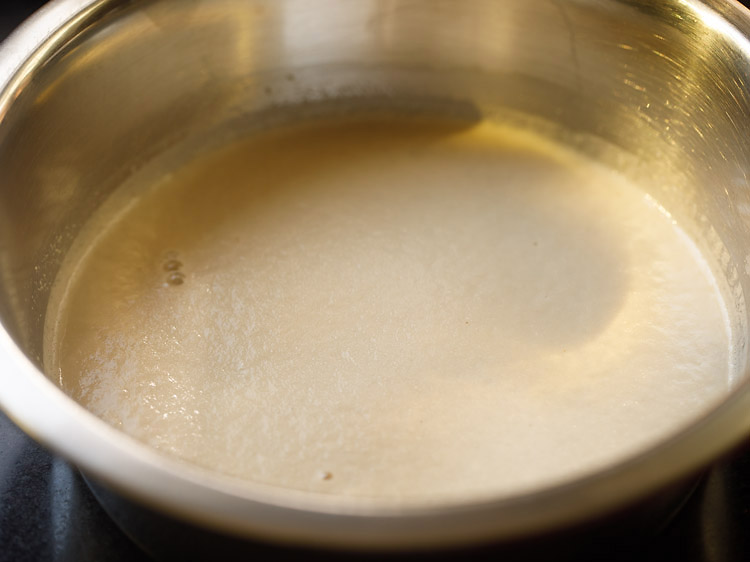
4. Combine 1 cup of unbleached all purpose flour (or bread flour) with 1 teaspoon of salt and 3 tablespoons of olive oil.
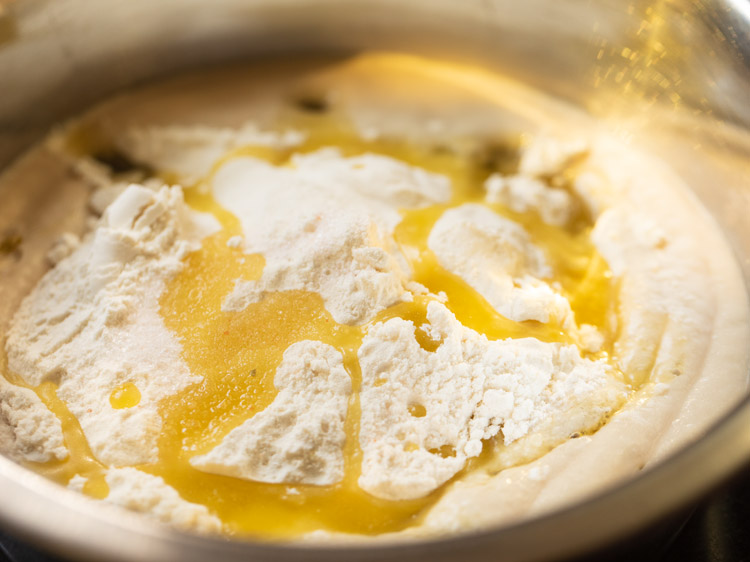
5. Stir with a whisk or wooden spoon or steel spoon.
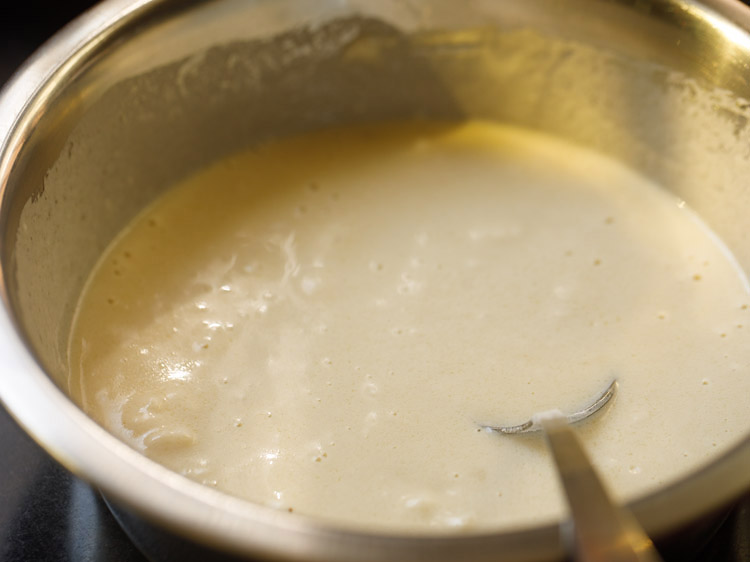
6. Add one more cup of the flour.
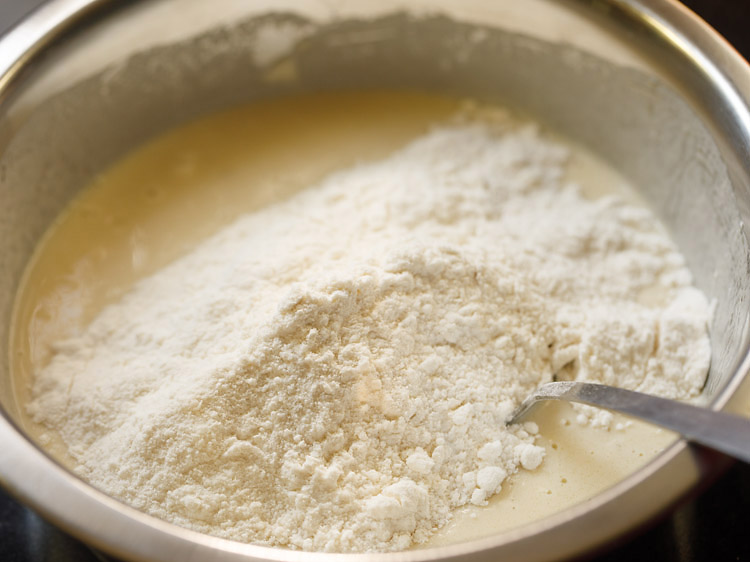
7. Keep on stirring. The mixture will be quite sticky, like in the photo below.
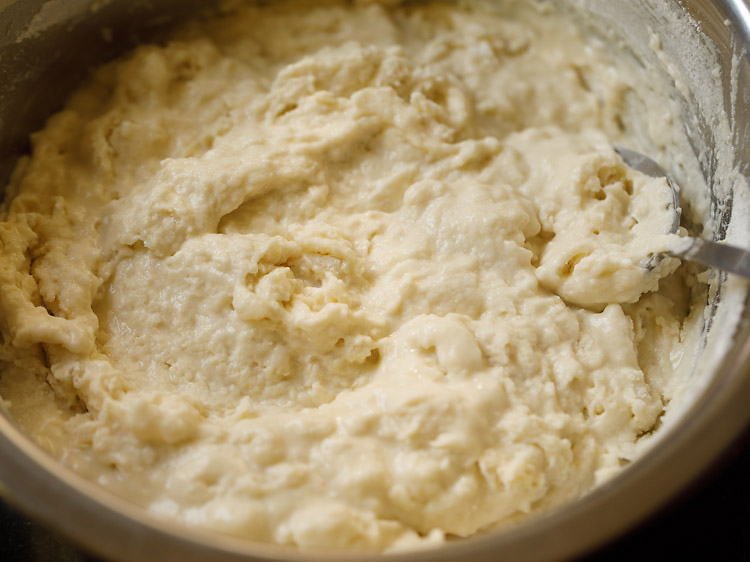
8. Add the last cup of flour and continue to stir. The dough will start to form and leave the sides of the bowl, but will still be sticky.
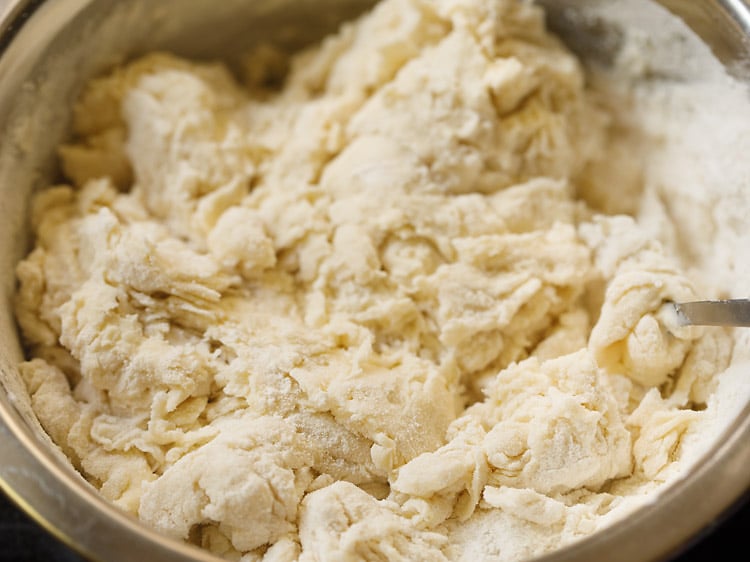
9. Now it’s time to knead the dough by hand until it forms a smooth dough. Dust with flour to prevent sticking as you work. The dough will be soft and elastic, and no longer sticky.
Tip: If the dough becomes sticky, sprinkle some flour and knead. If the dough looks dry and not smooth, sprinkle a bit of water and knead.
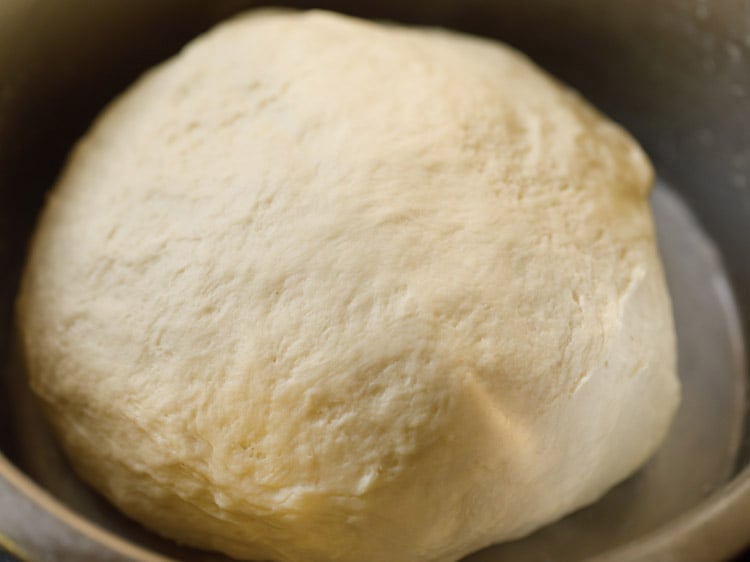
10. Keep your dough in the deep bowl, and lightly apply a bit of olive oil all around the outside of the dough. This will keep it from sticking to the sides of the bowl once the dough proves and grows.
Cover loosely with a kitchen napkin or towel, and let rest at room temperature for the dough to leaven:
- 45 minutes to 1 hour for instant yeast
- 1.5 to 2 hours for dry active yeast
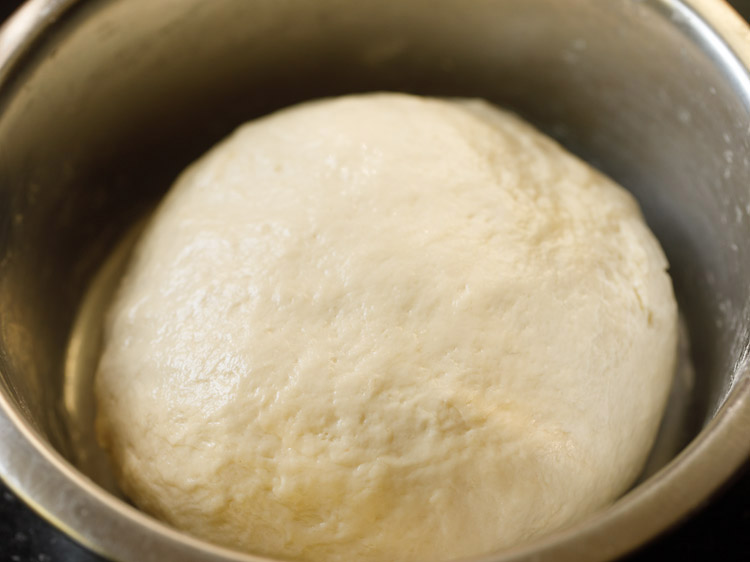
11. After exactly 1 hour my dough had risen and doubled up to what you see below.
If you plan to make the pizza the next day, then wrap the dough tightly in a plastic wrap and keep in the fridge.
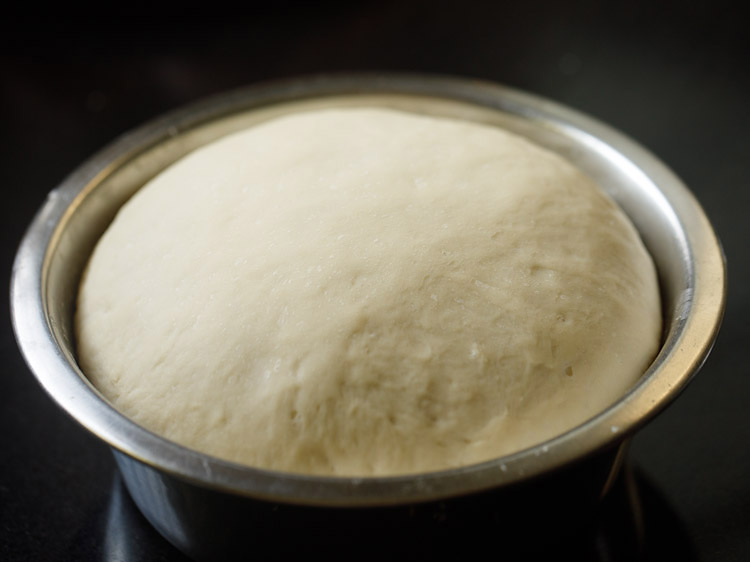
12. To make the pizza right away, portion and flatten the dough to a disk. In the below photo, you can see that the dough has leavened well, with stringy strands and many air pockets that will make a chewy crust.
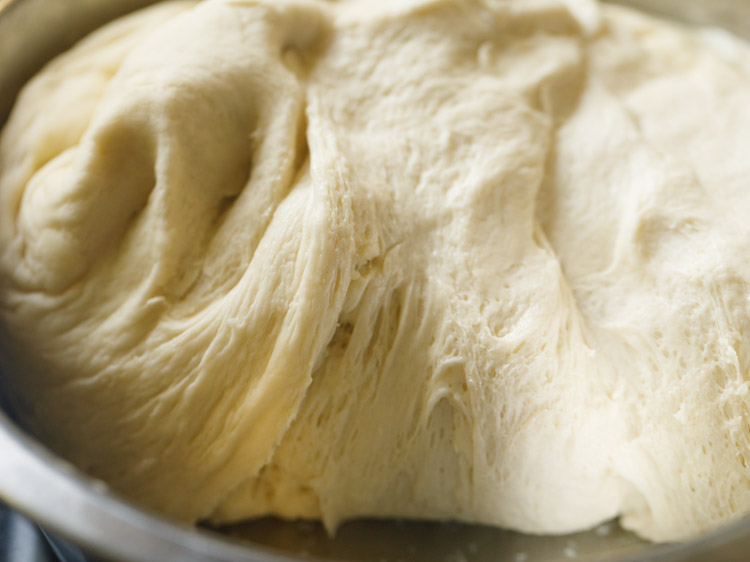
Make Pizza Sauce
You can easily make a zesty, robust tomato sauce while the dough is resting. The recipe makes for a bigger batch of tomato sauce which you can always refrigerate or freeze.
Skip this section if you have a premade packaged or canned pizza sauce and jump to the assembling and baking section below.
1. You can choose to either chop the tomatoes (500 grams or 5 to 6 medium tomatoes) and use them fresh to make the sauce, or blanch them first and then add in a blender.
Blanching will reduce the cooking time, but is not necessary for making a delicious sauce.
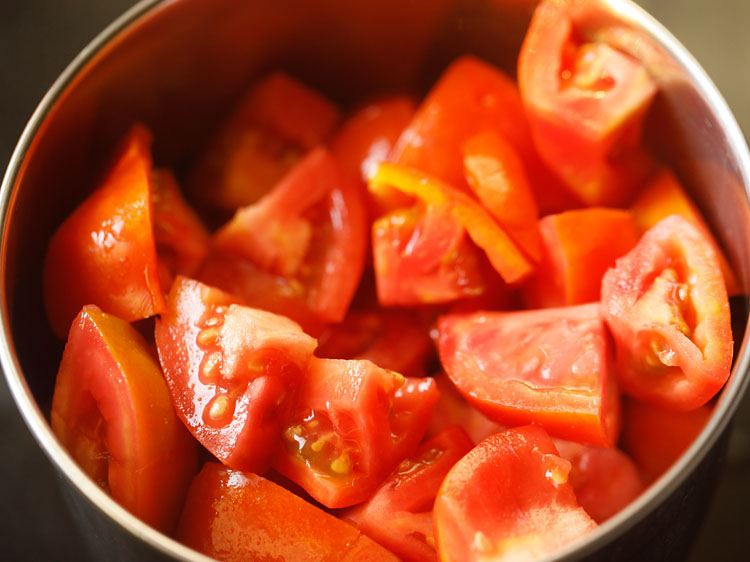
2. Crush the raw or blanched tomatoes in the blender to make a puree that is as smooth or chunky as you like for this pizza recipe.
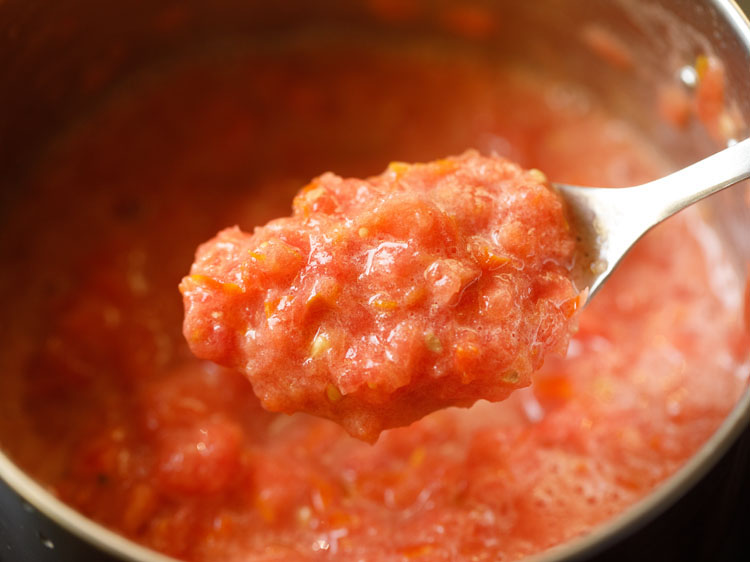
3. Next, in a large sauce pan heat ¼ cup olive oil, and add 2 teaspoons minced garlic. Sauté and stir for some seconds to soften the garlic.
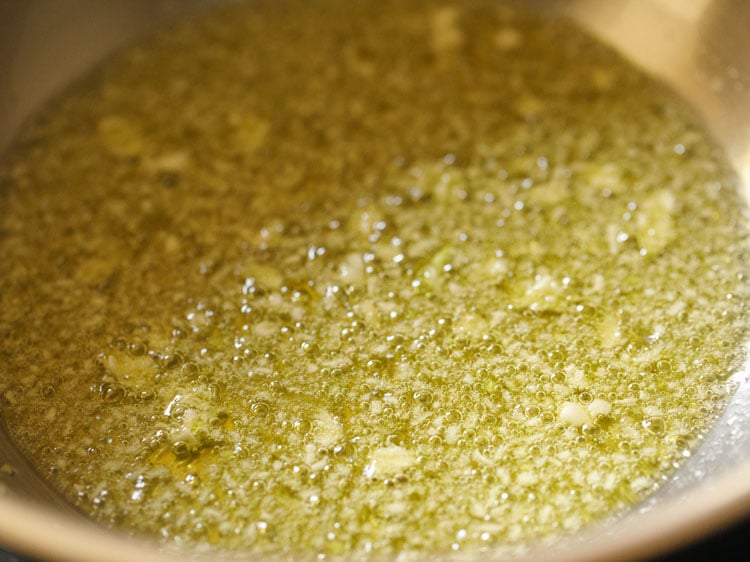
4. Now add the tomato puree, and mix well.
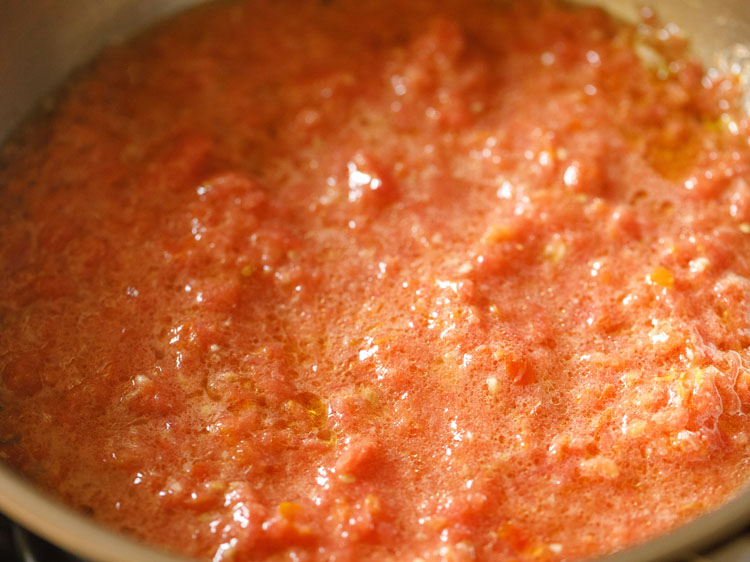
5. Continue stirring and let the tomatoes cook for 5 minutes.
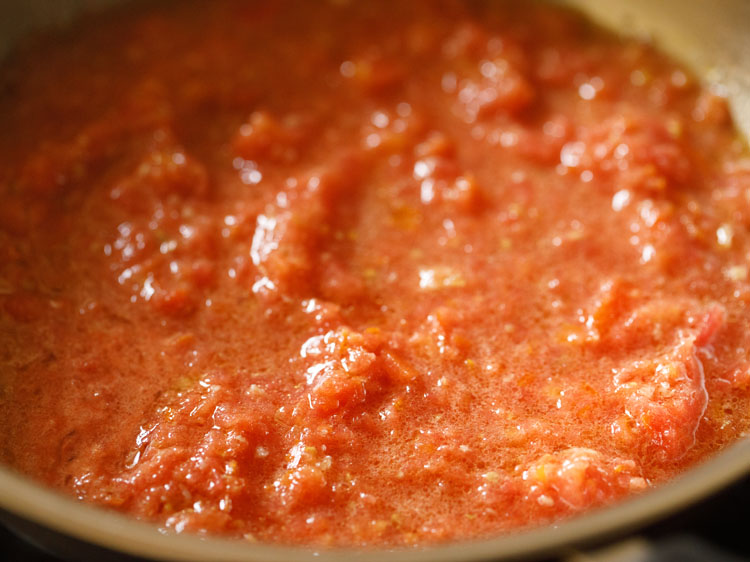
6. Add salt as needed. Mix and stir.
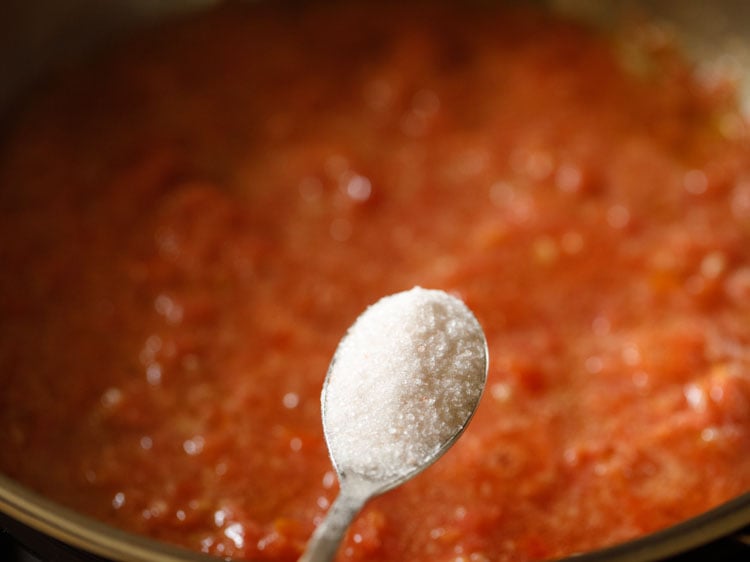
7. Cover the pan with lid and simmer the tomato sauce on low heat for 20 minutes, stirring occasionally, until the tomatoes have softened.
If the sauce looks too thick you can add ¼ cup water. Then cover and continue to cook.
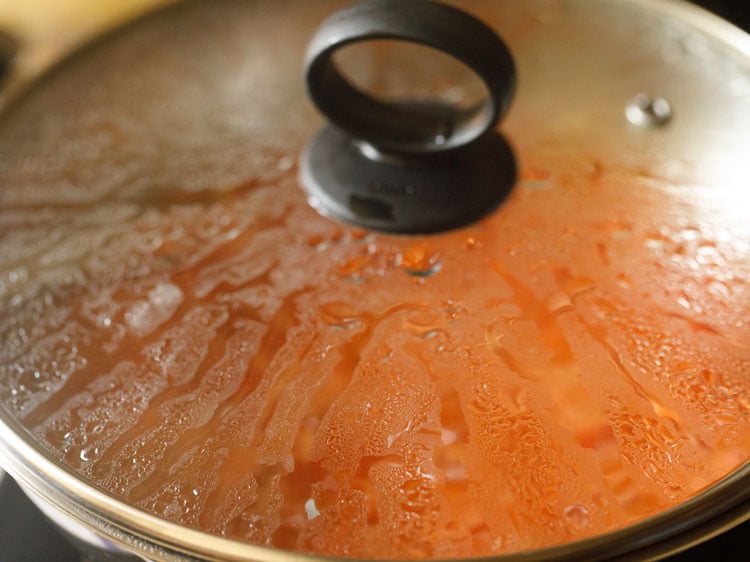
8. Simmer until the tomatoes have completely cooked and the sauce has thickened.
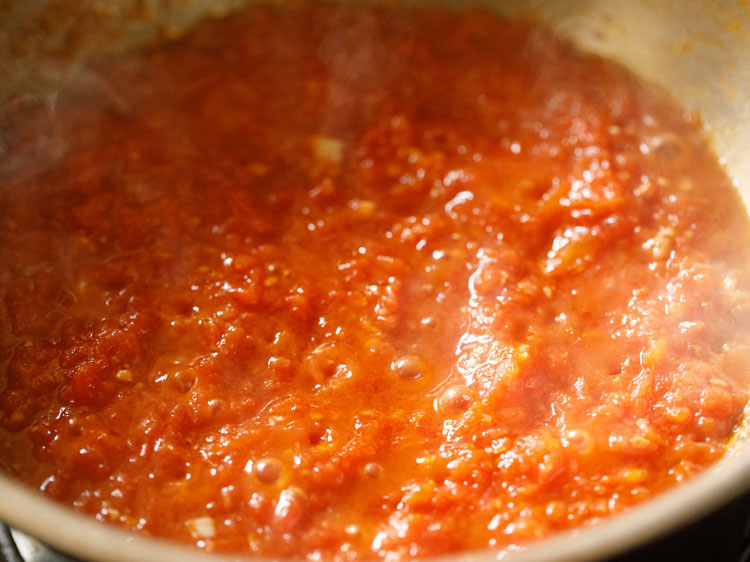
9. Stir in herbs and crushed black pepper.
For the pizza sauce seasonings in this recipe, you can add ¼ cup chopped basil (or 3 to 4 teaspoons dried basil), 2 to 3 teaspoons dried oregano (or 2 tablespoons fresh oregano) and fresh crushed black pepper as needed.
If you can I recommend using fresh herbs for the boldest Italian flavor.
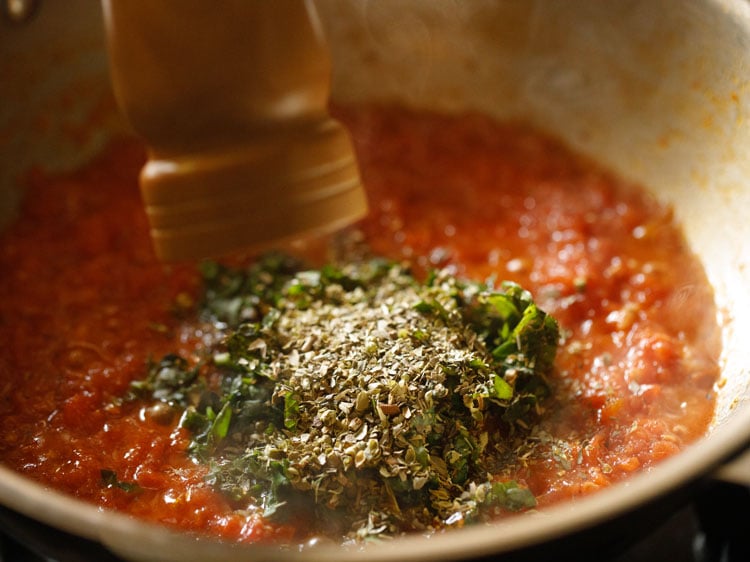
10. Mix the sauce well and set aside.
You can allow the pizza sauce to completely cool and store in an airtight container for up to 10 to 15 days in the fridge, or 3 months in the freezer, and use anytime you’re ready to bake the pizzas.
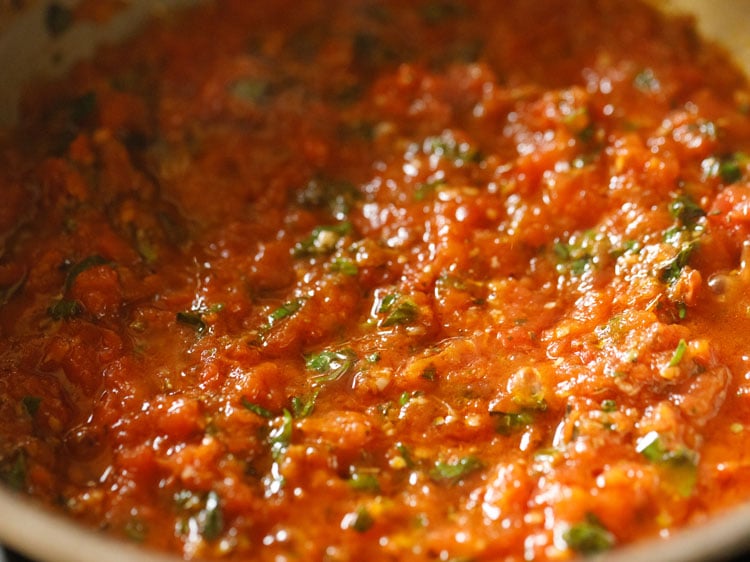
Assemble & Bake Pizza
1. First, preheat the oven to the highest temperature in your oven. In my oven it is 230 degrees Celsius (450 degrees Fahrenheit).
Use both the top and bottom heating elements of the oven as we want a uniform and even baking of the pizza.
Grease a round metal baking pan with olive oil, and then lightly dust it with maize flour (cornmeal), semolina (rava or sooji) or flour.
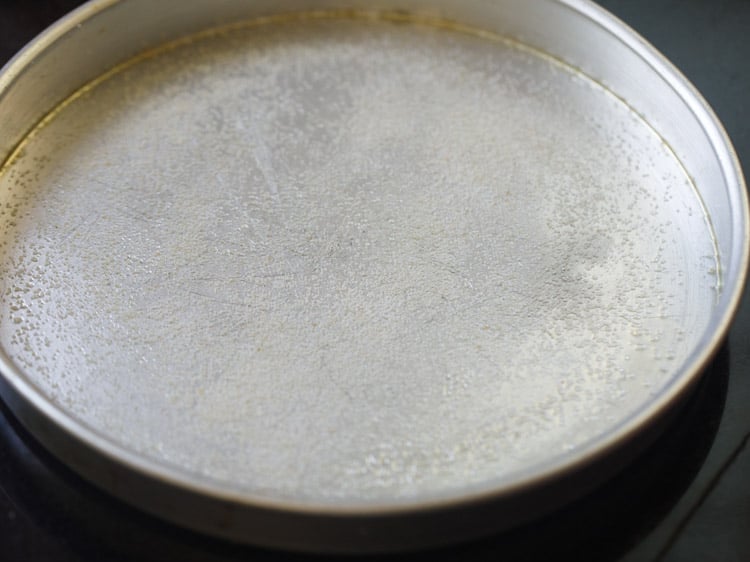
2. Divide the homemade pizza dough into equals parts to make either 4 small or 2 large or 3 medium size pizzas.
Wrap any dough you’re not using in plastic wrap and keep in the fridge for up to 3 days total.
To store in the freezer for up to 3 months, lightly coat the dough in olive oil and seal in an airtight freezer storage bag.
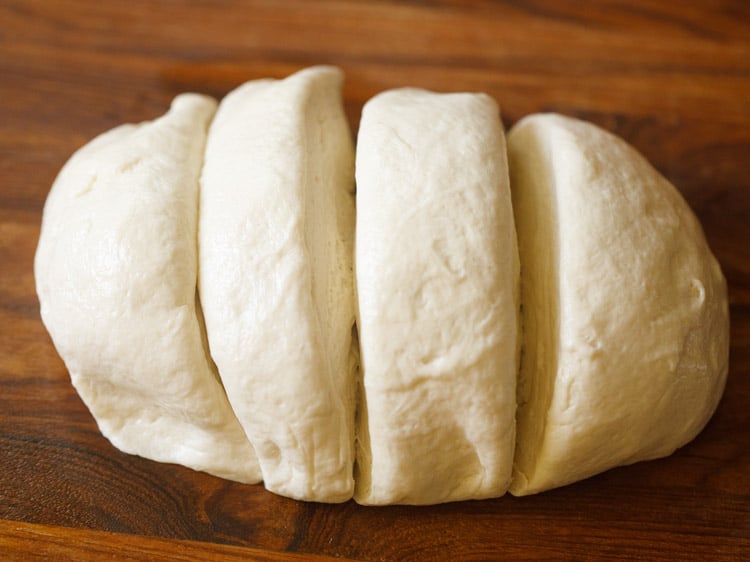
3. Using clean, dry hands, take one portion of the divided dough and roll it into a neat round ball.
Place on a cutting board or countertop that’s been lightly coated with some flour, and sprinkle the dough with a light dusting of more flour.
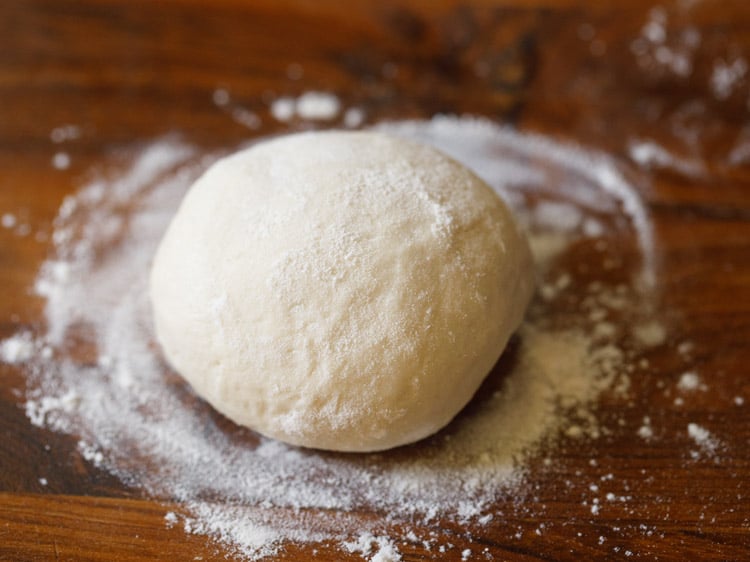
4. Use a rolling pin to roll the dough ball into a large round or oval shape of about ⅛ to ¼ inch thickness.
Roll the dough from the center towards the outer edges for the most even pizza dough. You may have to dust the surface with flour as you work.
A pizza dough is always stretched with hands and not rolled. Stretching the dough with your hands needs practice.
For most home cooks, rolling the dough is much easier and so I have included this step. You could also flatten and press the dough with your fingers directly in the baking pan.
I do stretch or flatten the dough with my hands but not everyone is good at this. Thus rolling makes it easier.
If you are a master at stretching dough with your hands, then go ahead with this technique.
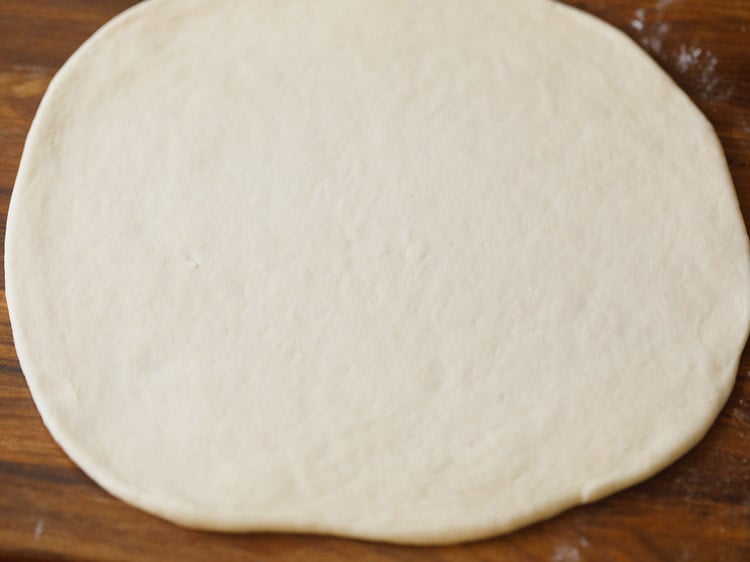
5. Once stretched to the desired size, gently place the pizza base in the greased baking pan. Be careful not to tear the dough, as it is very soft and stretchy.
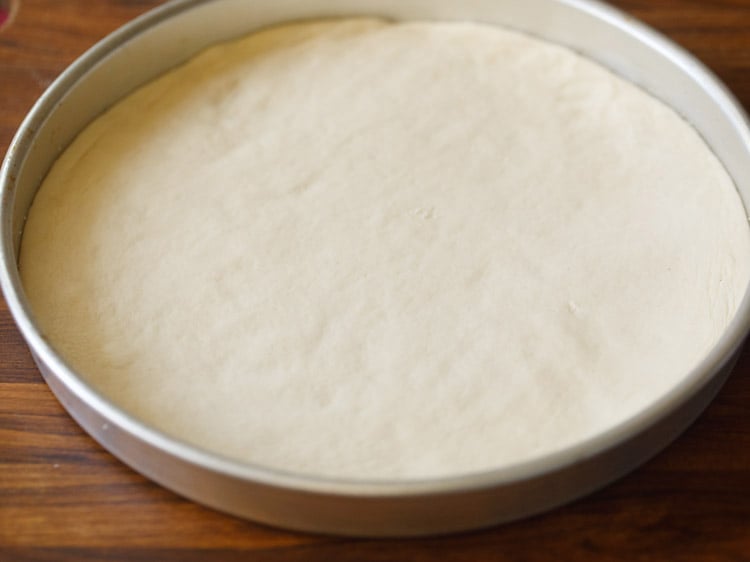
6. At this point you can prick the dough with a fork if you want a thinner, crisper crust. This also helps in the crust not puffing up when baking.
However, you can leave the dough as-is for a fluffier, chewier vegetable pizza crust.
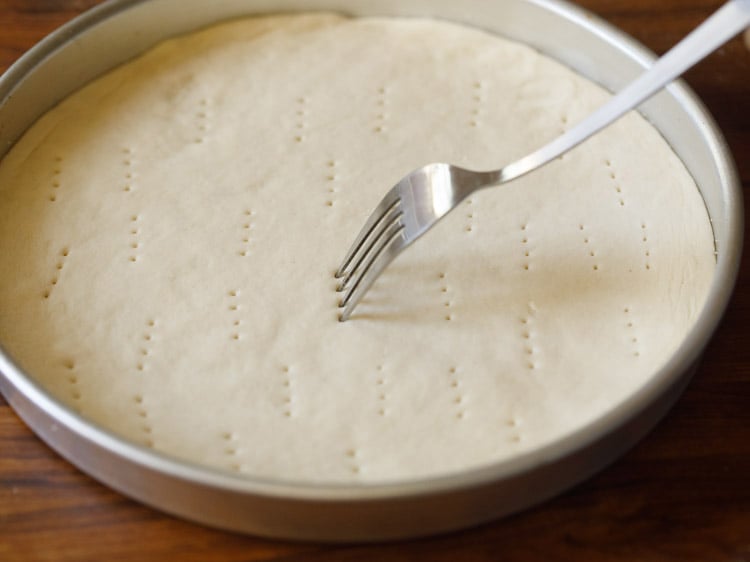
7. Use a pastry brush to lightly brush the surface of the crust with olive oil.
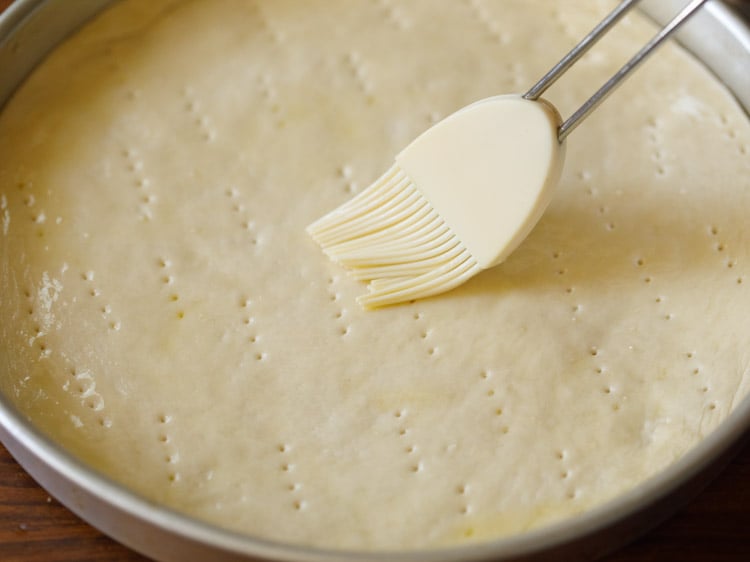
8. Then, spread the tomato sauce on the pizza in a thin, even layer. Leave about an inch of dough around the outer edge free from sauce for a perfect pizza crust.
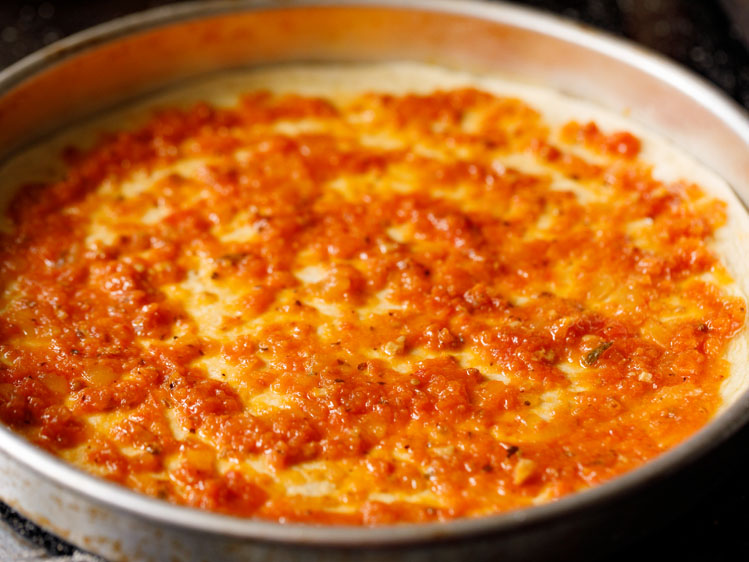
9. Top the sauce with a generous handful or two of shredded mozzarella cheese.
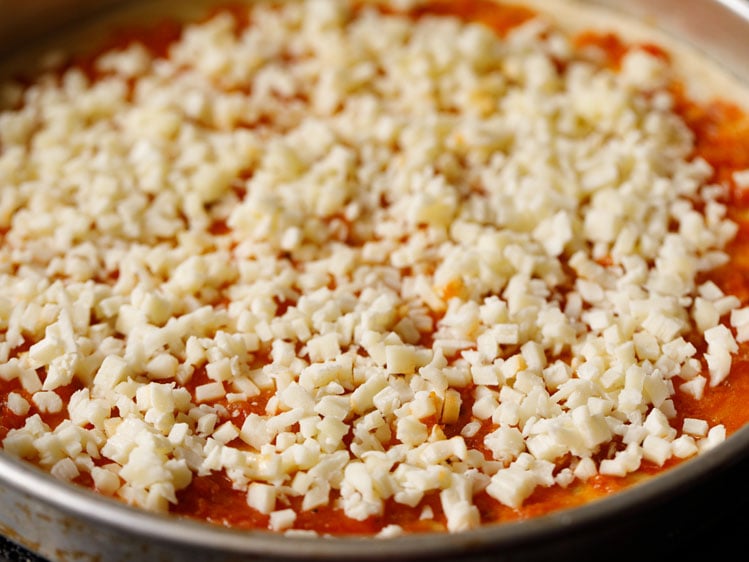
10. Place your choice of veggies on top of the cheese, making sure to spread the toppings evenly.
In the below photo, the vegetable toppings are red onion, green & red bell pepper and steamed corn kernels.
Keep reading for some of my suggestions for great pizza toppings for this Veggie Pizza recipe!
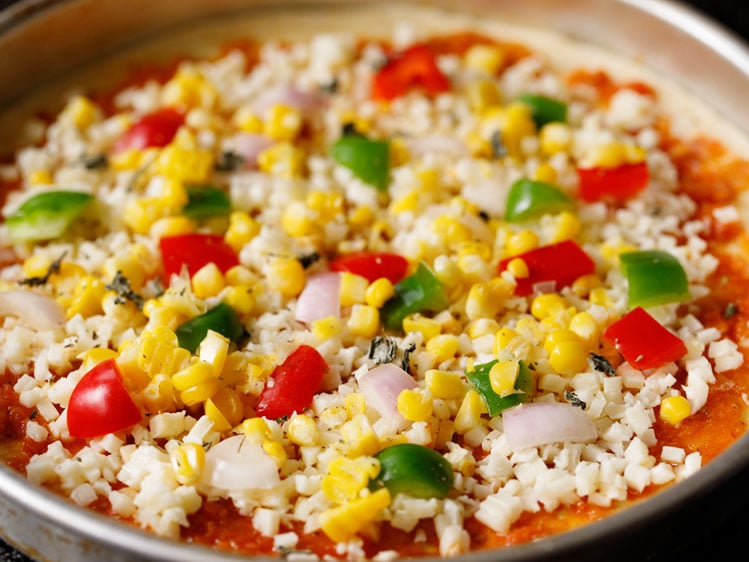
11. Here is another topping idea for you – a few mushrooms, onions, capsicum and green olives.
When using mushrooms make sure they are fresh and use them sparingly. Many mushrooms will make the crust soggy.
For an all mushroom pizza, sauté or stir-fry sliced mushrooms till they are light golden before topping them.
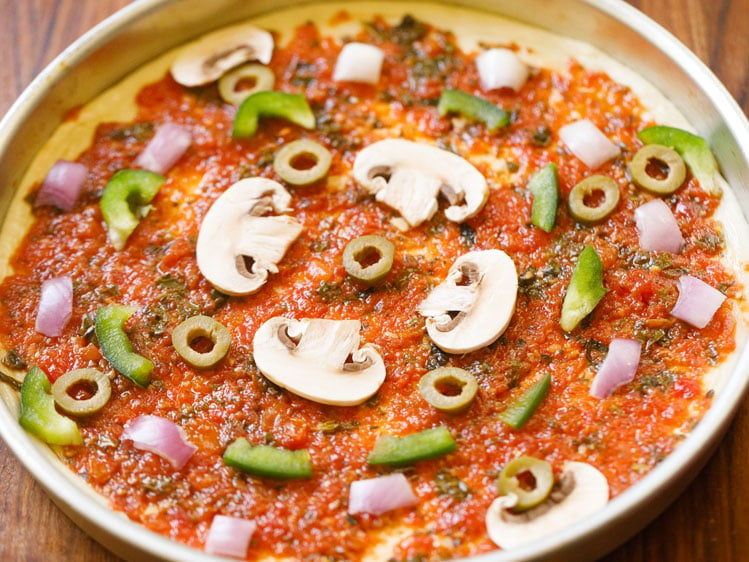
12. Next, add a light layer of grated parmesan cheese to finish the pizza.
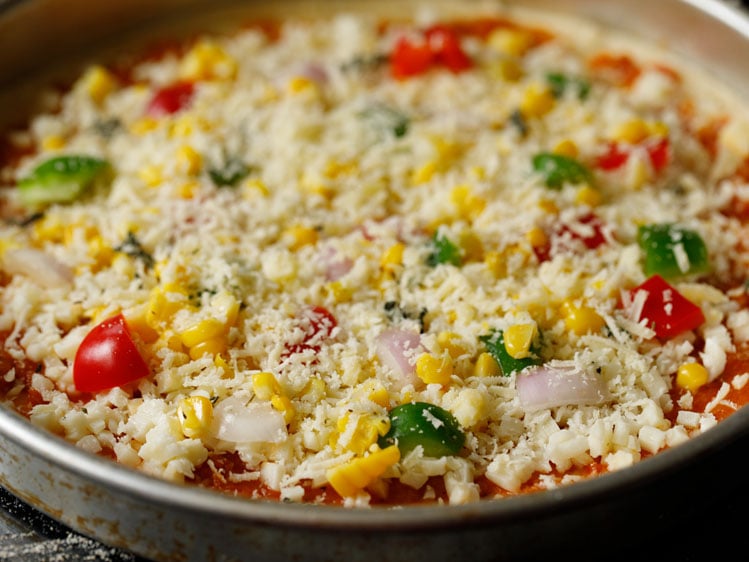
13. Place the baking pan close to the lower heating element (or you can keep it even on the crumb tray of your oven) to get the crispiest crust and perfectly molten, gooey melted cheese.
Bake the veggie pizza in the preheated oven for 10 to 15 minutes, until the cheese melts and the crust is golden.
Alternatively preheat a baking sheet in the oven for 20 minutes when you assemble the pizza in the baking pan.
Place the pan with the pizza on the hot baking sheet which will help in getting a crisp crust.
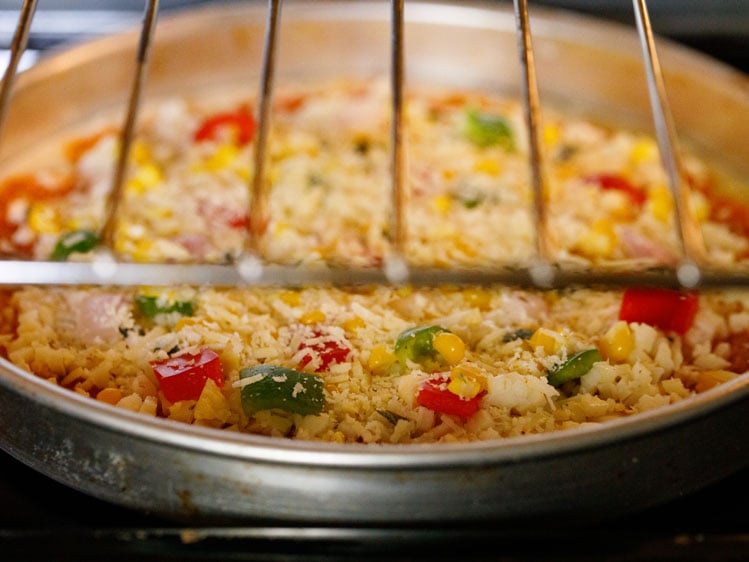
14. Your perfect personalized veggie pizza is now ready to enjoy!
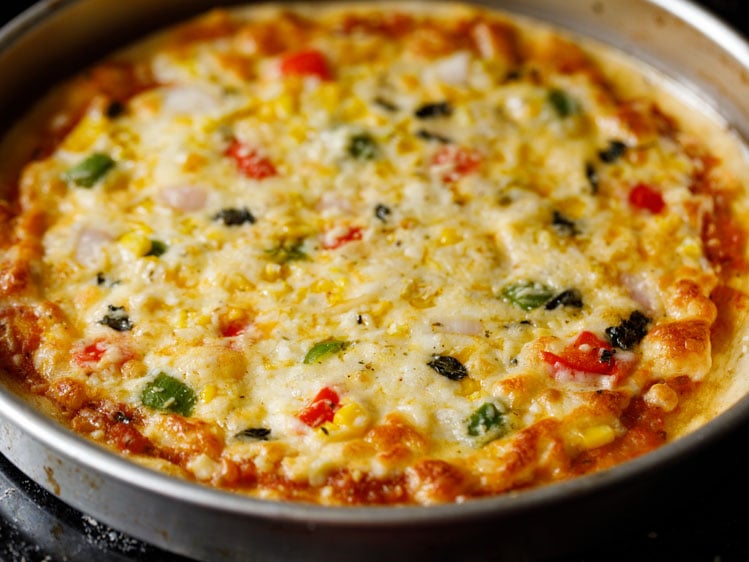
15. Wait for a minute or two and then serve the veggie pizza while still hot. Sprinkle red chilli flakes (red pepper flakes) or dried herbs or Italian seasoning.
If you have fresh basil leaves, garnish the pizza with torn or roughly chopped basil before serving it hot.
Leftovers can be kept in a sealed container for up to 1 day in the fridge.
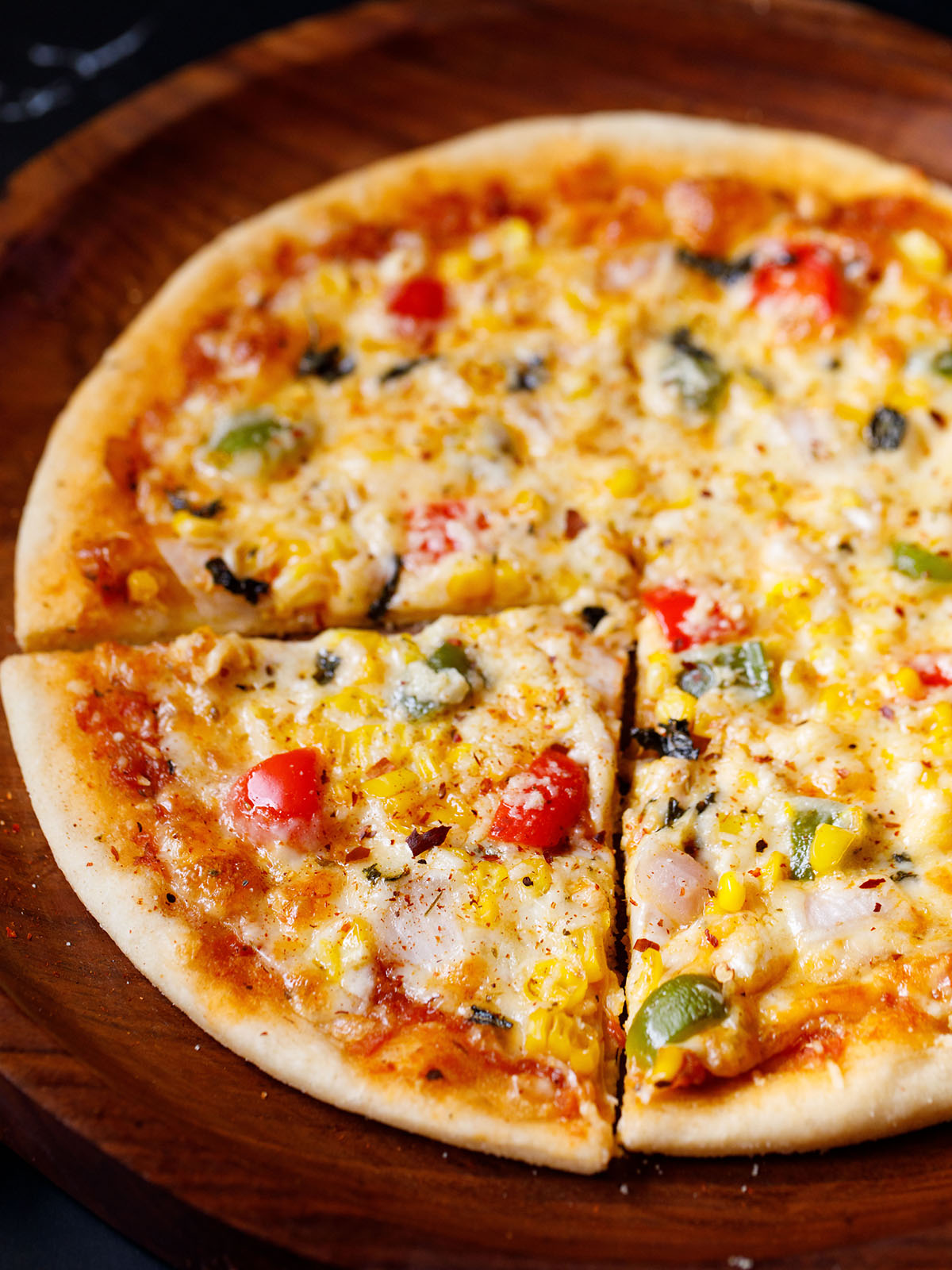
How to Personalize Your Vegetarian Pizza
You can choose any of your favorite toppings for making delicious vegetarian pizza at home!
- For mushrooms, I suggest you sauté them till light golden before adding them to the pizza. This will keep them from releasing moisture during baking and making the crust soggy. You could use button mushrooms or oyster mushrooms or shiitake mushrooms.
- Hearty veggies like onions, bell pepper (capsicum), and baby corn can be added directly without cooking first. If using corn, steam and use the kernels or use canned corn.
- For broccoli or French beans, lightly cook or blanch first. If you like olives and capers on your pizza, add them directly before baking or grilling the pizza.
- And for green vegetables like kale, fennel, cabbage, cauliflower, or shaved brussels sprouts, sauté or cook for just a few minutes before using in this veg pizza recipe.
- For a vegan pizza, feel free to use vegan plant-based non-dairy cheese for a vegan veggie pizza made from scratch.
Expert Tips
- Kneading Pizza Dough: If you have an electric mixer or food processor at home, you can use it to make the pizza dough. The dough has to be kneaded really well and should be soft, supple and elastic.
- More Kneading Tips: Add some more flour for a sticky dough. For a not so soft and bit dry dough, some more warm water can be added.
- Dough Versatility: This dough is versatile. Make a thin or thick curst pizza with it, the choice is yours. You can also opt to make pizza pockets or calzones with this dough with a filling of your choice.
- Storage: The leftover pizza dough can be refrigerated or kept in the freezer. The leftover pizza sauce also keeps well in the fridge for 4 to 5 days.
- Prepping Veggies: If you want, you can sauté the onions, bell peppers and steamed corn kernels lightly in olive oil before using them for topping.
- Scaling: You can easily halve, double or triple this pizza recipe.
FAQs
1. How should I use a pizza stone?
Preheat your pizza stone about 30 minutes to 1 hour. Assemble your pizza on a pizza peel or a flat tray or lid making sure that the pizza peel is evenly dusted with flour – this makes it easy for the pizza to glide from the pizza peel to the baking stone.
Gently slid the pizza with the help of a spatula on the preheated pizza stone and bake for 8 to 10 minutes until the cheese melts and you see crisp golden edges in the crust.
2. My pizza cooked well but the crust did not brown, why?
Try use a metal pan for the cooking of the crust if you are baking in the convection mode of your microwave oven.
If you have a regular oven or an OTG keep the pan near the lower heating element. The metal pan being a good conductor or heat becomes hot and this helps in making for a crispy crust in the pizza.
3. Why my pizza crust is hard or dense?
The pizza crust is always leavened with yeast. If the yeast does not activate well the dough won’t get leavened resulting in a dense, dry or hard texture. Ensure that you have a stock of a good brand of yeast.
4. Why has the cheese got separated and become rubbery?
If the pizza is baked for a longer time, the cheese will separate and become chewy or rubbery. Try baking for less time and at a high temperature.
More Questions Answered
You can use a glass baking pan or a ceramic plate or pan. But with both glass pan or ceramic pan, you won’t get crisp crust and the texture will be more like a bread.
Holy basil is more aromatic than Italian basil. Both have different flavor and aroma profiles. I would not suggest to add Holy basil as the pizza sauce can become bitter. But you can use Thai basil in place of Genovese basil.
You can use butter or a neutral tasting oil like sunflower oil or any good vegetable oil.
You can easily make pizza on a skillet or frying pan. You can check this recipe of Tawa Pizza (made on skillet).
You can check this No Yeast Pizza Dough recipe. Or you can make the pizza dough with a sourdough starter.
Yes you can – with whole wheat flour, there will be no chewiness in the pizza, but it will have a soft texture.
More Homemade Pizza Recipes To Try!
Bread Recipes
Italian Recipes
Best Thin Crust Pizza (Crispy Crunchy and Light Pizza Crust)
Italian Recipes
Paneer Recipes
Please be sure to rate the recipe in the recipe card or leave a comment below if you have made it. For more vegetarian inspirations, Sign Up for my emails or follow me on Instagram, Youtube, Facebook, Pinterest or Twitter.

Pizza Recipe | Homemade Vegetarian Pizza
Ingredients
For pizza crust
- 3 to 3.25 cups all-purpose flour or bread flour (unbleached), 375 grams
- ½ teaspoon sugar
- 1 cup warm water or add as required
- 1.5 teaspoons instant yeast 4 to 5 grams or 2 teaspoons dry active yeast
- 3 tablespoons extra virgin olive oil
- 1 teaspoon salt or add as required
- 1 to 2 teaspoons extra virgin olive oil for brushing dough
- semolina or cornmeal (makki ka atta) or all-purpose flour for sprinkling on pan
For pizza sauce
- 5 to 6 medium tomatoes – 500 grams
- 2 teaspoons minced garlic or 8 to 10 small to medium garlic cloves, 5 grams peeled garlic
- ¼ cup extra virgin olive oil
- ¼ cup chopped basil or 3 to 4 teaspoons dried basil
- 2 teaspoons dried oregano or 2 tablespoons fresh oregano
- freshly crushed black pepper or ground black pepper, as required
- salt as required
Toppings (Include Any)
- 1 onion sliced or cut in cubes
- 1 capsicum (bell pepper), sliced or cubed
- 1 tomato chopped or sliced – optional
- 10 to 12 pitted green olives sliced, optional
- 10 to 12 pitted black olives sliced, optional
- ½ cup steamed sweet corn kernels or canned corn kernels
- ⅓ cup sliced baby corn – optional
- ⅓ to ½ cup sautéed kale – optional
- ⅓ cup sautéed spinach – optional
- ⅓ to ½ cup cauliflower, fennel, brussel sprouts, cabbage (steamed, roasted or sautéed)
- ½ to 1 cup sautéed button mushrooms – optional
- ⅓ to ½ cup broccoli or french beans (blanched or sautéed) – optional
- Italian seasoning – as required
- mozzarella cheese or pizza cheese, as required
- parmesan cheese (vegetarian), as required
- red chili flakes – as required
Instructions
Making pizza dough
- In a large mixing bowl take the instant yeast, sugar and lukewarm water.
- Stir and let the mixture sit at room temperature for 10 to 15 mins till it becomes frothy,
- Add one cup flour, salt, olive oil to the frothy yeast mixture.
- Mix well. Add another cup of flour and mix again. The mixture becomes sticky.
- Add the last cup of flour and continue to stir.
- Knead the dough into a smooth, springy ball. Apply some olive oil all over the dough.
- Cover loosely and keep in a large bowl at room temperature for 45 minutes to 1 hour.
- The dough will double up and nicely leaven.
Making pizza sauce
- Crush or make a smooth puree of the tomatoes in a blender.
- Heat olive oil. Fry the minced garlic for some seconds. Add the tomato puree. Mix and let cook uncovered for 5 minutes.
- Season with salt and mix. Cover and simmer the tomato sauce on low heat for 20 minutes, stirring occasionally, until the tomatoes have softened.
- If the sauce looks too thick you can add ¼ cup water. Then cover and continue to cook.
- Add the herbs and crushed black pepper. Mix well.
Assembling and baking veg pizza
- Preheat your oven at 230 degrees Celsius (450 degrees Fahrenheit) for 20 minutes. Use both the top and bottom heating elements of the oven for an evenly baked pizza.
- Cut the dough in 3 or 4 equal parts. Flatten the dough to a disk. On a lightly floured surface roll the dough having ⅛ to ¼ inch thickness.
- Place the dough onto a greased and dusted pan.
- Brush some olive oil on the pizza base. Spread the tomato sauce on the pizza.
- Top shredded mozzarella cheese and veggies.
- Sprinkle some grated parmesan cheese.
- Keep the tray near or close to the bottom heating element of your oven.
- Bake for 10 to 15 minutes at 230 degrees Celsius (450 degrees Fahrenheit) until the base becomes golden brown and the cheese on top melts.
- Wait for a minute or two and serve veggie pizza while still hot.
Video
Notes
- You could use a 1:1 proportion of whole wheat flour and all-purpose flour to make the pizza crust.
- Feel free to add your choice of veggies. While onions and bell peppers (capsicum), tomato, can be used raw, you will need to roast, steam, boil or sauté other veggies like sweet corn, potato, spinach, zucchini, eggplants accordingly.
- If including a lot of mushrooms, sauté them in some olive oil until light golden before topping them on the pizza.
- For a vegan option, opt to use a plant-based non-dairy cheese.
Nutrition Info (Approximate Values)
This Pizza Recipe from the archives was first published in April 2012. It has been updated and republished in February 2024.
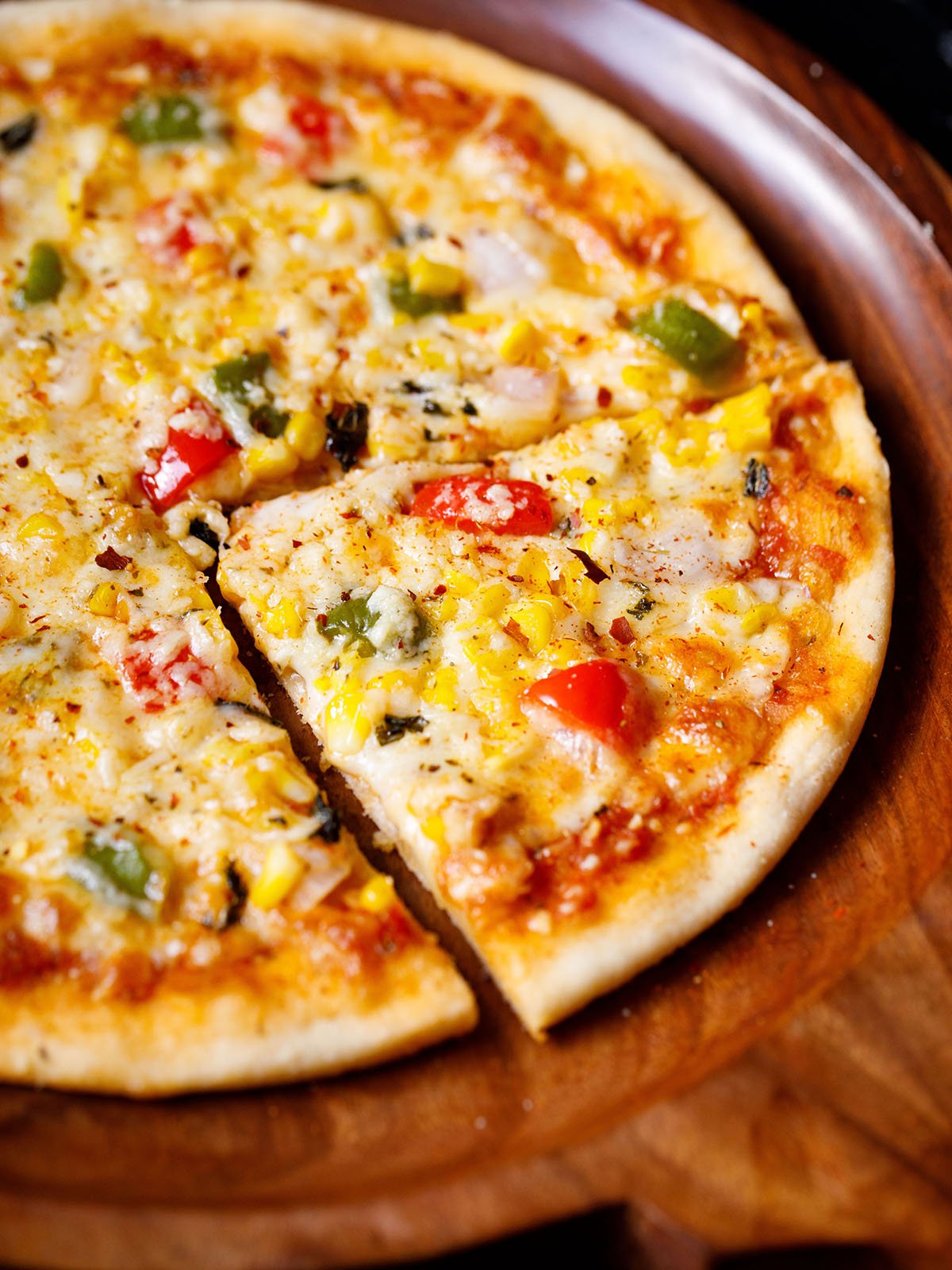

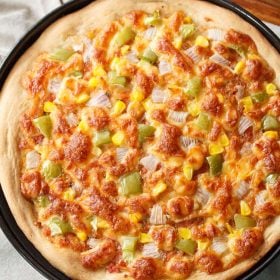
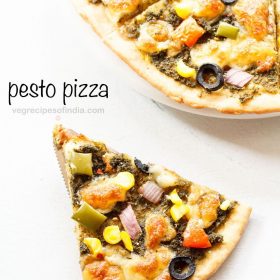

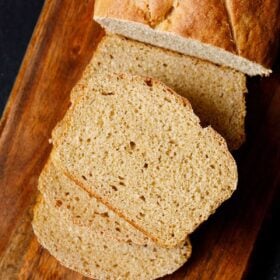
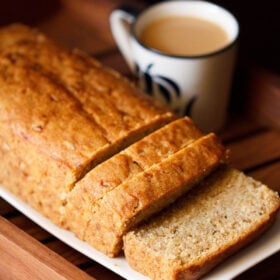
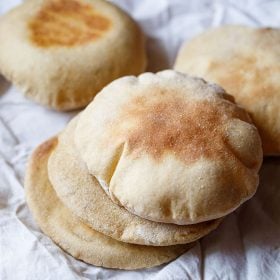
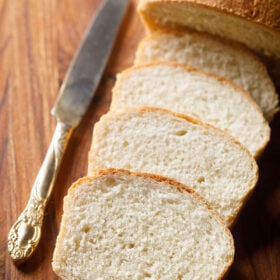









Hi
Can u please tell me the alternative for olive oil?
use any neutral flavored oil like sunflower oil.
Thank you so much for this recipe.I made it for dinner today.We loved it.This was the best pizza recipe I have tried.I was searching for veg pizza recipes for quiet a long time,I am happy I found this recipe.I will try your whole wheat Pizza next.?
surlky try reshmi and thankyou for your kind and positive words 🙂
Italians take for the pizza dough instead of common flour “farina 00”, which contains less starch. That’s the flour for real pizza. The dough becomes elastic, the artistry some pizzaioli master by throwing it into the air, is only possible with this flour. And it tastes much better. And I don’t take honey, but a pinch of Cayenne Pepper.
thankyou for sharing this information tobias 🙂
A question what if I make a whole large pizza with the whole dough instead of dividing it …..would the steps followed would be same or different?????
the steps would be the same. just that you will add all the toppings at once on the pizza.
Would love to try this pizza recipe. What can I use as substitute for olive oil?
olive oil is always traditionally used. though you can use a neutral flavored oil like sunflower oil.
so easy recipe i like it & how to make it from pan
farin, you can make in a pan following this method – firstly use a heavy and thick bottomed large tawa or pan. keep the flame on sim or low. spread some oil or butter on the pan all over. place the rolled pizza dough without the toppings first. lightly cook the base. just a light brown. flip. now the cooked side will come on top. then quickly spread the pizza sauce, add all the toppings,including cheese on the partly cooked part. cover the pan with a lid and cook till the base becomes golden and crisp. the cheese will also melt. do use a heavy thick bottomed pan and keep the flame on low. otherwise the base gets burnt. keep everything ready, so that you can add the toppings quickly when the other side is cooking.
Hello andi, I don’t kno y my pizza turn out to b a disaster.. Actually I thought of making whole wheat pizza n tried too..Mine is IFB rotisserie convection model meeru chepinatea chesanu kani pizza base cook avaledhalu endi ponattu vachindii pls help…
Which Herbs should we use especialy ?
neha, oregano and basil.
I am not getting dry yeast. Could it be replaced with something else?
aditya, no replacement. you can get from a good general store or super market.
Hi…I bought cheddar cheese today can I use it in this recipe in place of mozzarella cheese??
monika, the cheddar cheese makes the pizza little oily or greasy. you can use but the texture of cheddar cheese is different. its up to you. if you are fine with the texture then you can use it.
Thank you very much for this recipe.. Made it for dinner today and everyone In my family liked it..I used paneer tikka as topping and mixed mozzarella and cheddar cheese…it tasted great…but there was just one issue..the base was not completely cooked from the bottom…I made it in convection mode and used the grill rack to keep the pizza plate..can u suggest why this must have happened?
after taking the pizza out of the oven I had to cook it in a pan for 1 min to cook it’s base completely..but the final result was fabulous 🙂
when cooking in the convection mode of a microwave oven, there is not heat that comes from the bottom, unlike an OTG, where there are bottom heating rods. so its always better to keep the pizza in an aluminium tray or pan as then the aluminium conducts heat and the base cooks well as gets a golden crust. this will not be possible if a grill rack is used. meaning when the pizza is kept on a grill rack. also what plate you used on the grill rack. an aluminium plate or tray should work. but a glass one will not give good results.
Thanks ma’am will try once again n will let u know about my experience… But this recipe is indeed the best one I have ever come across..:)
welcome monika 🙂
Brilliant ! Tried it yesterday and everyone loved it 🙂 just faced one problem .. I dont have pizza pan / tray for my convection (don’t have oven) so base wasn’t getting equally cooked and was very difficult to put the round shaped pizza on little grill in convection with all the toppings.. Had zigzag pizzas :p kindly advice wat to do to get evenly cooked pizza
if you can get a small sized tray for the grill, then you will get an evenly cooked base. otherwise make small or mini pizzas and place them on the grill (one at a time or two mini pizzas at a time) depending on the width of the grill. should work and the base should also be evenly cooked.
Thanks 🙂 will try and can i bake cakes in convection
welcome kajal
Hi..will u please tell us which brand yeast u prefer..
i use mauripan/gloripan brand of yeast.
Hey can you please tell me for how much extra time can we keep the dough apart from those 2 hrs..?
after 2 hours or after the time taken for the first rise, then you need to keep the dough in the fridge. if kept outside for a longer time, the texture as well as the taste will change.
Excellent i never seen pizza recipe easy like this
thankyou sp much pritish 🙂
thankyou so much pritish 🙂
Hi
I like this recipe.. But my dough comes out very tangy..
thankyou manisha but whats making the dough tangy? ideally it shouldn’t taste tangy.